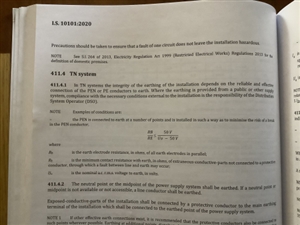
Perhaps you can shed some light on this condition for TNCS systems in the Irish Rules. I can only see that as RE decreases RB becomes more onerous but to be honest I am not really getting the essence.
I did the sums using RB=20 and RE=100
Then I decided that the other side of the equation always stays the same, so RB/RE has to greater than or equal to 0.2631ohms,
so if RB is 20 ohms RE cannot be more than 5.26 ohms.
I did the sums using RB=20 and RE=100
Then I decided that the other side of the equation always stays the same, so RB/RE has to greater than or equal to 0.2631ohms,
so if RB is 20 ohms RE cannot be more than 5.26 ohms.
We're about to take you to the IET registration website. Don't worry though, you'll be sent straight back to the community after completing the registration.
Continue to the IET registration site